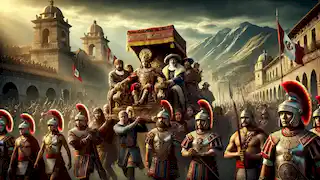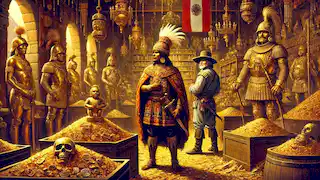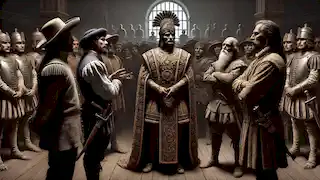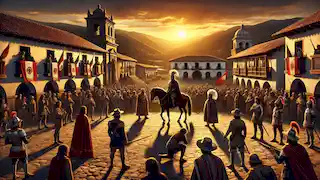The Legend of Atahualpa’s Ransom Room
Reading Time: 7 min

About Story: The Legend of Atahualpa’s Ransom Room is a Legend from peru set in the Renaissance. This Dramatic tale explores themes of Loss and is suitable for Adults. It offers Moral insights. A legendary deal of gold and betrayal in the heart of the Inca Empire.
The year was 1532. Deep within the heart of the Inca Empire, the once-great kingdom trembled under the shadow of foreign invaders. Francisco Pizarro, a determined Spanish conquistador, had arrived on the shores of Peru with dreams of unimaginable wealth and conquest. Little did he know, his encounter with the great Inca ruler, Atahualpa, would set in motion a story of greed, betrayal, and a ransom that would echo throughout history.
In Cajamarca, a city nestled within the Andes Mountains, there existed a room that would become the centerpiece of one of the most infamous deals in human history. This is the story of Atahualpa’s Ransom Room, where a king's fate and a nation’s future were decided. The Inca Empire was vast, stretching from modern-day Colombia down to Chile, and for nearly a century, its people had known peace and prosperity under the rule of powerful Sapa Incas. Atahualpa, son of the previous Sapa Inca, had recently emerged victorious in a bloody civil war against his brother Huascar, solidifying his claim to the throne. However, his victory was to be short-lived. As Atahualpa celebrated in Cajamarca, news came to him of the arrival of strange, bearded men who wielded weapons of thunder and rode on enormous beasts. These were the Spanish conquistadors led by Pizarro, men who had crossed the seas not just to explore, but to claim, conquer, and plunder. Atahualpa was not one to be easily intimidated. Confident in the superiority of his empire, he agreed to meet with these foreign visitors. The meeting took place in the main square of Cajamarca, a fateful encounter that would forever change the course of Inca history. As Atahualpa arrived on a golden litter, carried by his retainers, the square was eerily quiet. The Spanish soldiers stood ready, hiding behind their makeshift barricades. Pizarro approached the Inca ruler, offering him a Bible as a symbol of Christianity and European authority. However, Atahualpa, unaccustomed to such books, tossed it aside, seeing it as a meaningless object. This act, though insignificant to the Inca emperor, was the spark that ignited a bloody conflict. The Spanish, using their superior weaponry, attacked the unarmed Incas, capturing Atahualpa and slaughtering his soldiers. The once-mighty ruler was now a prisoner in his own land. After his capture, Atahualpa found himself confined to a small room in Cajamarca. Here, the ruler, once feared and respected by thousands, was at the mercy of his captors. Pizarro and his men, though victorious, were well aware of the immense power and resources the Inca Empire possessed. It was in this moment that an audacious plan was born—a ransom so vast that it would make Pizarro one of the richest men in the world. Atahualpa, seeking his freedom and believing he could outwit the Spaniards, proposed a deal. He offered to fill the room in which he was held captive with gold, reaching as high as his outstretched arm. Pizarro, enticed by the promise of such wealth, agreed to the terms, though he had no intention of truly releasing the Inca king. In the days that followed, the Inca people, loyal to their emperor, brought treasures from every corner of the empire. Gold statues, jewelry, and ceremonial objects began to pile up in the room, each piece worth a fortune. The Incas, believing they could save their beloved ruler, worked tirelessly to meet the ransom. The room, known today as the Ransom Room, slowly filled with gold and silver. Despite the immense wealth being offered, tensions grew between the Spanish. Greed began to overtake reason, and many questioned whether they should allow Atahualpa to live, fearing that he could raise an army against them once freed. As the ransom continued to grow, Atahualpa's fate hung in the balance. Despite his captivity, he maintained a regal air, confident that the gold would buy his freedom. However, Pizarro’s men were growing restless. Rumors spread that Atahualpa was secretly communicating with his generals, plotting a rebellion against the Spanish invaders. Pizarro himself began to doubt the wisdom of releasing the Inca emperor. He had seen firsthand the loyalty the people had for Atahualpa, and he knew that as long as the ruler lived, he posed a threat to Spanish domination. In the end, it was not the gold that sealed Atahualpa’s fate, but fear and suspicion. In a mock trial orchestrated by the Spaniards, Atahualpa was accused of plotting a rebellion and worshipping false gods. The verdict was inevitable—death. Despite having fulfilled his part of the bargain, the great Sapa Inca was sentenced to die by garrote, a cruel execution reserved for traitors. On the night of his execution, the once-mighty ruler of the Inca Empire was led to a platform in the main square of Cajamarca. As the garrote was tightened around his neck, Atahualpa’s final breath marked the end of an era. The Inca Empire, weakened by civil war and now leaderless, was ripe for conquest. Even after Atahualpa’s death, the gold continued to arrive. The Spanish had promised to release him once the room was filled, but the room remained stacked with treasure long after his execution. The gold and silver were eventually melted down, turned into ingots, and sent back to Spain. The riches that had once adorned temples and palaces became part of the spoils of war. But the legend of the ransom lived on. The Inca people, devastated by the betrayal, whispered stories of the lost gold that never made it to Cajamarca, hidden away in secret caves and mountain sanctuaries. Some believed that vast treasures still lay buried in the Andes, waiting for those brave enough to seek them out. For the Spanish, the conquest of the Inca Empire brought untold wealth, but it also came at a great cost. The once-great civilization, with its towering cities and advanced knowledge, was reduced to ruins. The greed that had driven Pizarro and his men to capture Atahualpa also sowed the seeds of their own downfall. Internal conflicts, rebellions, and the harsh terrain of the Andes made it difficult for the Spanish to maintain control. The Ransom Room in Cajamarca still stands to this day, a silent witness to the betrayal and greed that shaped the course of history. Tourists from around the world visit the site, marveling at the small, unassuming room where so much wealth once passed through its walls. But for the descendants of the Inca, the room is a reminder of a tragic chapter in their history—a moment when an empire fell, not through battle, but through treachery. Atahualpa’s story remains one of the most poignant in the annals of history. He was a ruler who, despite his greatness, could not foresee the full extent of the Spaniards’ ambition. His ransom, one of the largest ever recorded, did not save him, but instead became a symbol of the greed that fueled the European conquest of the Americas. {{{_04}}} Even today, the legend of the Ransom Room captivates historians, treasure hunters, and travelers alike. Some search for the lost gold of the Incas, hoping to uncover the treasures that never reached Cajamarca. Others reflect on the moral lessons of the story—the dangers of greed, the clash of civilizations, and the high price of betrayal. In the end, Atahualpa’s legacy is one of both tragedy and resilience. Though his empire was conquered, the culture of the Inca people survived, passed down through generations. Their language, traditions, and stories continue to live on in the Andean highlands, a testament to the enduring spirit of the Inca civilization. The legend of Atahualpa’s Ransom Room is not just a tale of gold and betrayal—it is a window into the collision of two worlds. The Inca Empire, with its rich history and culture, stood as a testament to human ingenuity and strength. But in the face of European ambition, it was brought to its knees by treachery and greed. Atahualpa’s ransom, though it failed to save his life, has lived on through the centuries as a symbol of the high price of conquest and the resilience of a people who refused to be forgotten.The Meeting of Worlds
The Ransom of a King

Betrayal and the Fall of the Empire

The Fate of the Ransom

The Legacy of the Ransom Room
Conclusion

















